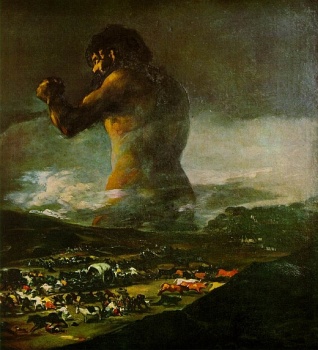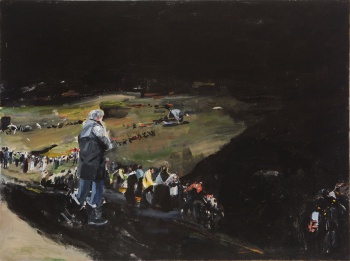In these ‘tough economic times’ everything seems to be measured in dollar value and if that kind of value isn’t readily discernable, we often assume there is no other value either – or none that matters. It’s behind personal financial expert Suze Orman’s diatribe against teachers (who, according to Suze, can’t possibly have any self-respect if they’re willing to work for so little money), and behind a general devaluation of arts and culture - other than those aspects that have a proven monetary value. I think we’re missing something that the artists and scientists of the Renaissance period understood well, when an artist, poet, architect and scientist were not necessarily different individuals.
These thoughts came to mind as I was showing a copy of the new edition of my book, UML for the IT Business Analyst to a friend who is an artist. I pointed out the new painting on the cover, and he recognized it right away from a previous exhibition. But there the interest ended. Unsurprisingly, he had no idea what the diagrams inside meant - but he could not even entertain the idea that he might be able to understand them. It got me wondering why it so unusual for somebody who works in the arts today to have an aptitude or interest in ‘computers’ (by which I really mean software design and analysis, as opposed to, say, being able to use applications like Photoshop, which almost every visual artist knows how to use).
As in the arts – so in business: eyes roll when the subject turns to IT (Information Technology). Some people are just not that into it; but sometimes it’s just that they are intimidated by it - convinced from the outset that they’ll never get it. It’s a protection mechanism. (Either way, it’s something BAs need to be aware of. One practical implication, for example, is that the documentation that is presented to non-technical audiences should not lean too heavily on analysis diagrams: their association with IT is enough to damn them for many readers.)
In any case, I don’t mean to rag on my artist friends. The ‘2 solitudes’ argument cuts both ways. Few of my friends in the IT world are interested in art either: they don’t go to art shows, don’t buy art (posters don’t count); don’t look at paintings or ‘art’ photographs. The reasons, I think, are pretty much the same as for the artists who don’t do IT: not interested, or convinced they’d never get it. For the second group - those who are simply intimidated by art but want to know more, it helps to have a guide.
At the moment (and for the next week), I have a show of paintings up in a gallery. I’ve been taking people on ‘guided tours’ of the show – each time focusing on a different piece.
This blog is a virtual version of that – focusing on one of the paintings in the current show, ‘Colossus’.
 The title refers to another painting by the same – ‘The Colossus”, attributed to Francesco Goya, a Spanish painter who painted it in the early 1800’s. Goya lived in a time of great upheaval and war – and this is reflected in his work. In the original painting, the Colossus is a giant man who towers in the sky above the human turbulence below.
The title refers to another painting by the same – ‘The Colossus”, attributed to Francesco Goya, a Spanish painter who painted it in the early 1800’s. Goya lived in a time of great upheaval and war – and this is reflected in his work. In the original painting, the Colossus is a giant man who towers in the sky above the human turbulence below.
My painting is not an attempt to redo the Goya; it’s more of a riff on it. In my version, the Colossus of the Goya has been replaced by … well, me. But I’m standing on solid ground, not striding across the sky. And I’m wearing Sorel winter boots. (Because this is Canada.) This is one of the first paintings I started while working on the show, but I finished it last. It’s a summing up of all that I’d done in series. Its subject is war and people on the move, the migrations we hear about every day in the news and the endless migrations that have preceded them. The people in the painting come from: a photograph, a painting of a village by the French artist, Eugene Boudin, and one or two Black paintings by Goya – a mixing of pasts and the present and timeless wanderings.
This remixing of disparate sources is something that art - the process of making it and looking at it - excels at: the ability to see, as in this case, that there is a way to make a connection between a contemporary photograph, an early French Impressionist painting and some very sombre Spanish depictions of the human condition in times of war. 
Whereas science and technology are largely about following disciplined, repeatable processes to arrive at a result, art encourages the mind to wander between ideas and see unexpected relationships. It's a skill the Business Analyst needs to develop when looking, for example, for a common thread behind a slew of customer complaints or when coming up with a novel approach to solve a problem.
There's a bleed, in other words, between the ways of thinking promoted by art and those promoted by science. Which is why I think it's a good idea to explore both, as opposed to staying within one silo ... not that there's anything wrong with that.
And a couple more art links:
Howard Podeswa
 P.S. After much work, the new edition of UML for the IT BA is now being printed. Many thanks to all those in the ModernAnalyst community who contributed their thoughts via this blog. While I wasn’t able to thank you all individually in the book, there is a big shout-out to the group in the book’s acknowledgements and, in particular, to Adrian Marchis, for establishing and supporting this vibrant community.
P.S. After much work, the new edition of UML for the IT BA is now being printed. Many thanks to all those in the ModernAnalyst community who contributed their thoughts via this blog. While I wasn’t able to thank you all individually in the book, there is a big shout-out to the group in the book’s acknowledgements and, in particular, to Adrian Marchis, for establishing and supporting this vibrant community.